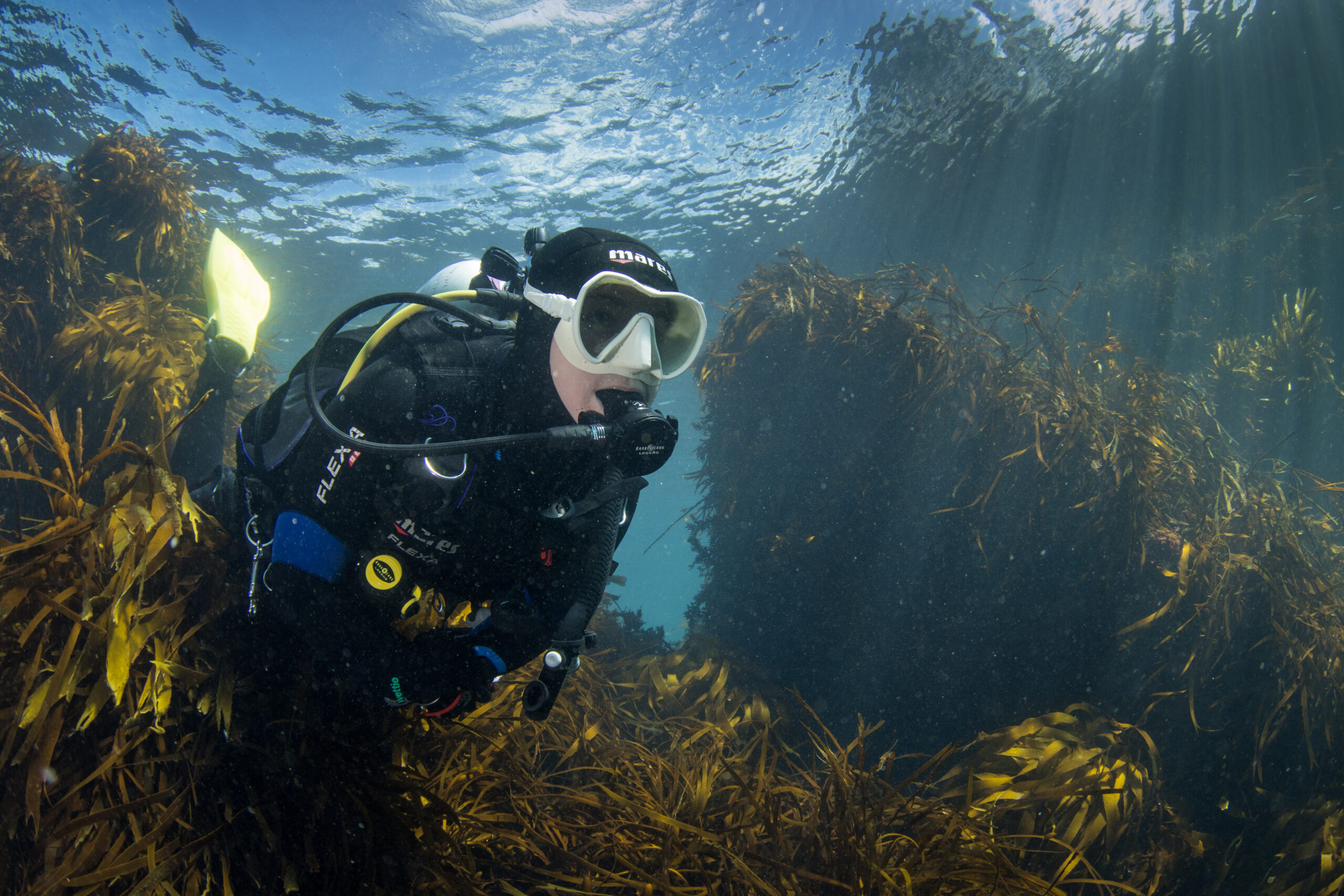

Dr Miller’s dive diary
Wellington is the only capital city with a fully protected marine reserve right at its doorstep. To show the diversity of marine life along the coast and Wellington Harbour Explore Your Coast founder Dr Nicole Miller is scuba diving 70 km of coastline bringing back observations and creating immersive virtual experiences that allow everyone to explore our coast from dry land. Her dive diary gives you a taste of the process behind the first part of the 70 km dive.
Saturday 27 January
It’s raining and windy just as forecasted.
The boat, equipment and volunteers are ready to go, so we push on and find a close-by section of coast to dive. Petone foreshore is our only option, but the overnight rain has muddied the water with poor visibility next to the Hutt River. Dropping below the surface, I try to focus my eyes and to see how far I am from the bottom. My fin tips touch the ground and I adjust my buoyancy carefully not to stir up sediments further. I start gliding along with the underwater scooter, keeping just high enough above the seafloor without losing sight of it. The outline of a big scallop comes into view, a large horseshoe mussel, a couple of hermit crabs, snails and various sea stars. I take it as a win to be underwater at all, and keep going.
Taputeranga Marine Reserve (TMR) is my beacon of hope. It shows how resilient the marine environment is if we act early enough and pull back pressures such as overfishing.
Sunday 28 January
Diving in the reserve is always exceptional. Since its establishment in 2008, heavily fished species like crayfish and paua have repopulated the reefs, and the variety of fish life is amazing, with big schools of moki, large inquisitive blue cod and lots of smaller fish. Taputeranga Marine Reserve (TMR) is my beacon of hope. It shows how resilient the marine environment is if we act early enough and pull back pressures such as overfishing. It’s cool seeing octopus out hunting crayfish, and crabs and blue cod trying to get an octopus tentacle, with other fish checking out what’s going on.
On the way to the back of Taputeranga Island we motor over the scuttled F69 Frigate, now an artificial reef. It is home to schools of fishes, sponges and a few crayfish. We get ready and I drop into the water. The visibility is not ideal but I am thrilled to see the dense seaweed forest. Following the edge of the reef leads to one of my favourite dive spots, Elsdon Pipe. I spot a huge conger eel and a school of moki! I continue along large sand wave patterns that lead me across Houghton Bay to Princess Bay.
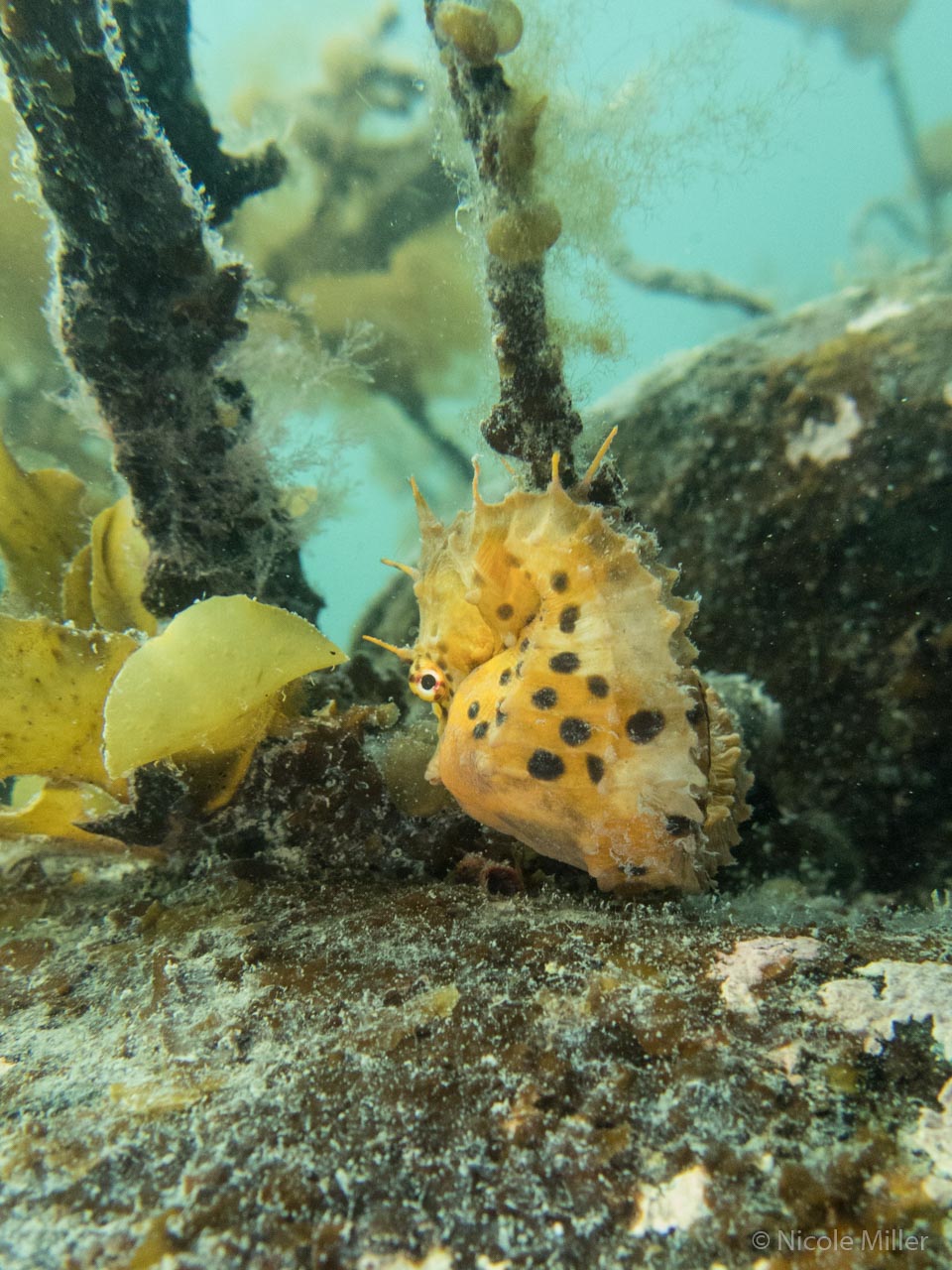
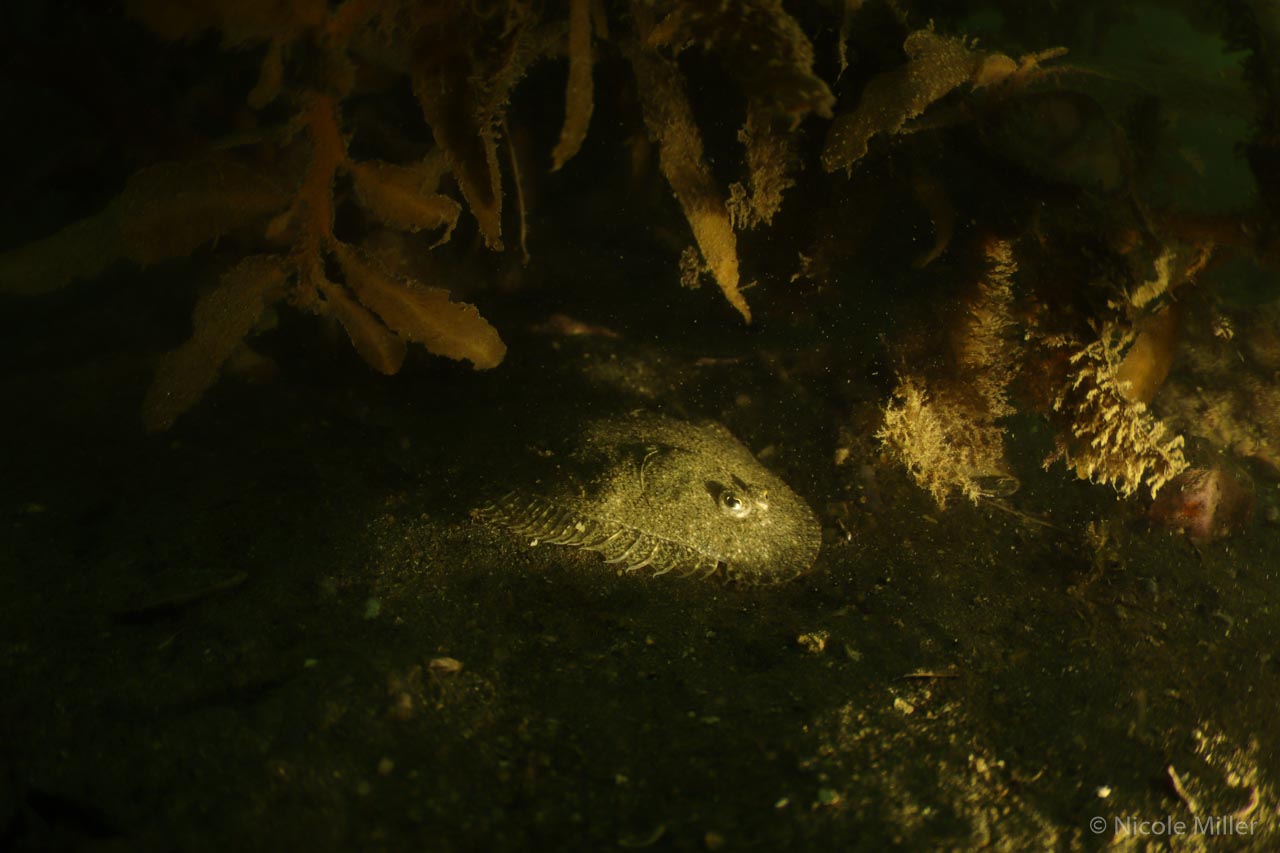
Saturday 3 February
Wāhine Wai, one of our local swimming groups, has organised an early morning fundraising swim. Outreach is a big part of Explore Your Coast, and it is great to connect with people who enjoy the coast. I love meeting Breanna, an ocean swimmer training to swim Foveaux Strait to raise awareness for marine conservation.
Due to strong winds we focus on shore diving. I am looking forward to diving with friends who travelled from Taranaki to support Explore Your Coast (EYC). Our first dive begins at the giant kelp forest at Worser Bay. As soon as Dee puts her head underwater she points to a seahorse.
Today’s main outreach event is a kina cooking demonstration at Scorching Bay. Our volunteers show how to open kina with a kina cracker and use a teaspoon to remove the roe. We have kina three ways: fresh from the shell (raw or on bread), on sushi rice with wasabi soy sauce, or as pasta dish “spaghetti ai ricci di mare”, with sea urchins, olive oil, garlic, a little chilli and parsley.
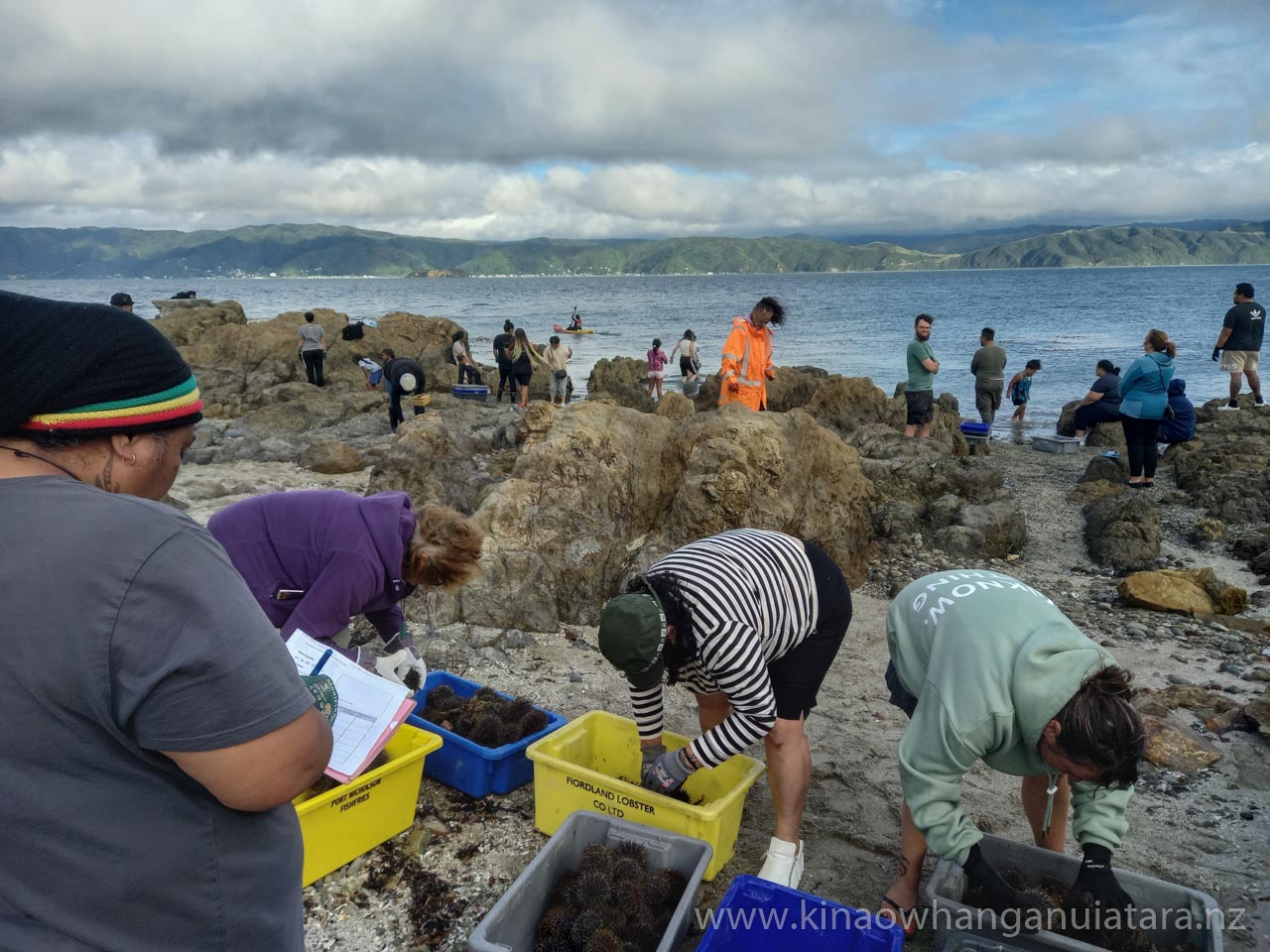
Sunday 4 February
It’s a beautiful morning around the other side of the harbour, at Days Bay, where we meet up with Claire from Dive HQ and volunteer divers for an underwater clean-up at the wharf. Divers collected 238 pieces of rubbish including scooters, a kid’s bike, construction materials, watches, sunnies and a mobile phone.
The beach was buzzing with the Days Bay Nippers families, cyclists and fishermen. A perfect day to get everyone trying out the virtual reality (VR) headsets and experience a dive in Taputeranga Marine Reserve on the beach. I love seeing the kids’ reactions to being virtually underwater and coming face-to-face with blue cod, laughing and talking about their “underwater” experience.
For the afternoon we head back to the Island Bay Snorkel Trail in the marine reserve. The visibility isn’t great but we get to see an octopus close up!
Tuesday 6 February, Waitangi Day
The wind is still blowing strong northerlies, so Suzie, Miett and I set up the EYC banner and VR headsets on Taranaki Wharf on Wellington Waterfront for a couple of hours in the morning. The VR tour provides something new and engaging for everyone. Divers enjoy seeing different sites, snorkelers get a different perspective of the marine reserve and people who haven’t experienced diving or snorkelling it is an absolutely new experience. We get chatting with a young disabled man who is stoked to dive underwater for the first time in his life.
Saturday 16 March
Skipper Nick takes the boat to the middle of the harbour so I can dive the northern end and eastern coast of Matiu/Somes Island. Old aerial images showed the island with large kelp forests, including some giant kelp but on previous boat trips past the island those kelp forests had disappeared.
Descending onto the rocky reef on the eastern side of the island confirmed that the seaweed forest was gone, apart from some seaweed in the very shallow areas. The rocky reef is stripped barren by an abundance of kina reaching up to one metre water depth. Kina don’t like the shallow areas but even here the kina have started to move up into the remaining seaweed. The kelp forests are the nurseries for crayfish and other species, but in kina barren there is nothing.
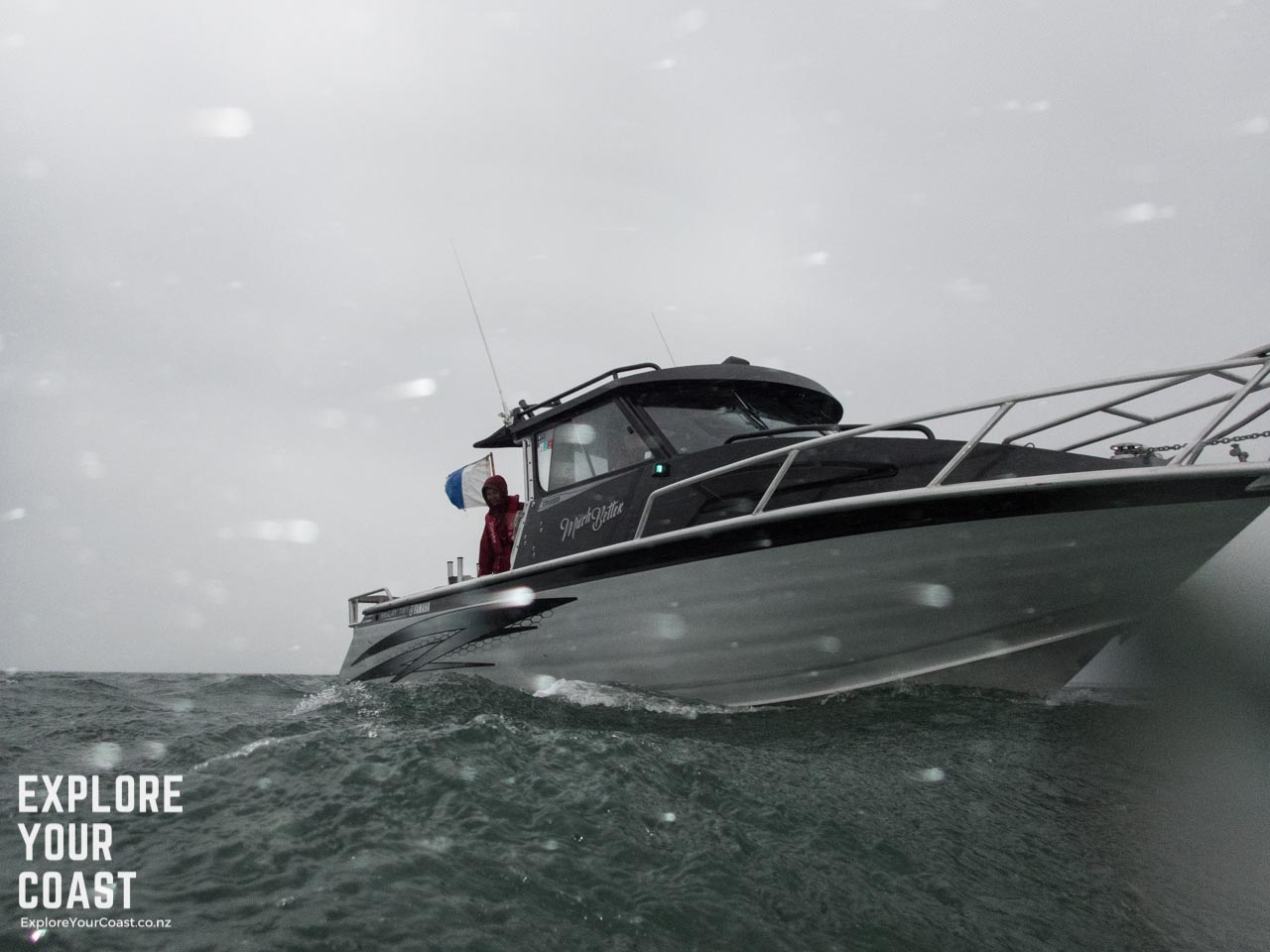
Sunday 24 March
Conditions today are suitable to dive the northern end of the Miramar Peninsula from Kau Point to Shelly Bay. I often spend time there, so decide to dive along the deeper part of the reef where new kelp is re-establishing after over 12,000 kina were removed from just 250m of coastline.Towards Point Halswell the reef changes into extensive kina barren and there is not much to see apart from barren rocks and kina. Some seaweed remains in the shallows. I see a small bright yellow seahorse hanging onto a small piece of seaweed. It catches my eye like a cry for help.
Saturday/Sunday 30/31 March, Easter Weekend
Our first dive starts close to the Wellington Airport sign on the Miramar Cutting, just north of the wharf where the boat in Peter Jackson’s movie King Kong was moored for some time. There is a big school of kahawai in the harbour, and fishermen pop up, cast over us and in minutes catch some good sized fish.
The reef looks as expected — a bit of seaweed in the shallows and lots of kina on the rocks. But a few look different. The red tissue on the kina shell is prominent and I notice the kina have lost their long spikes. Some also have lesions and their tissue is missing. This is new to me and a later Google search identifies it as Bald sea urchin disease (BSUD). “Most likely a bacterial infection that occurs in a wide range of sea urchin species and causes the loss of surface appendages”.
I start wondering how it looks in Shark Bay, a bit further along. Despite the name, divers enjoy night diving in Shark Bay and it is very common to see pipefish, a long, slender cousin of seahorses. They depend on the seaweed forest as habitat.
We get into the bay and I sense the seaweed is not as dense as it used to be. This feeling lingers and I remember many conversations with my dive buddies from a few years ago when we talked about the seaweed forests changing and disappearing, but we couldn’t quite say how. It’s the end of a long dive and we are cold and desperate to get out. I push the thoughts aside and decide to have another look again tomorrow.
The next morning I can see the seaweed forest has lost its density with bare rocks even in the more overgrown part of the site. Diving around a popular fishing spot I see a dead fish. It’s a skate that very likely got hooked and discarded. We don’t want our gear getting entangled in fishing lines so we continue diving north towards the tip of the peninsula and come across some of the denset areas of kina. Voracious eaters are crawling and piling up over remaining kelp. What a day.
Taputeranga Marine Reserve (TMR)Toitū te marae a Tāne-Mahuta, toitū te marae a Tangaroa, toitū te tangata. If the land is well and the sea is well, the people will thrive.
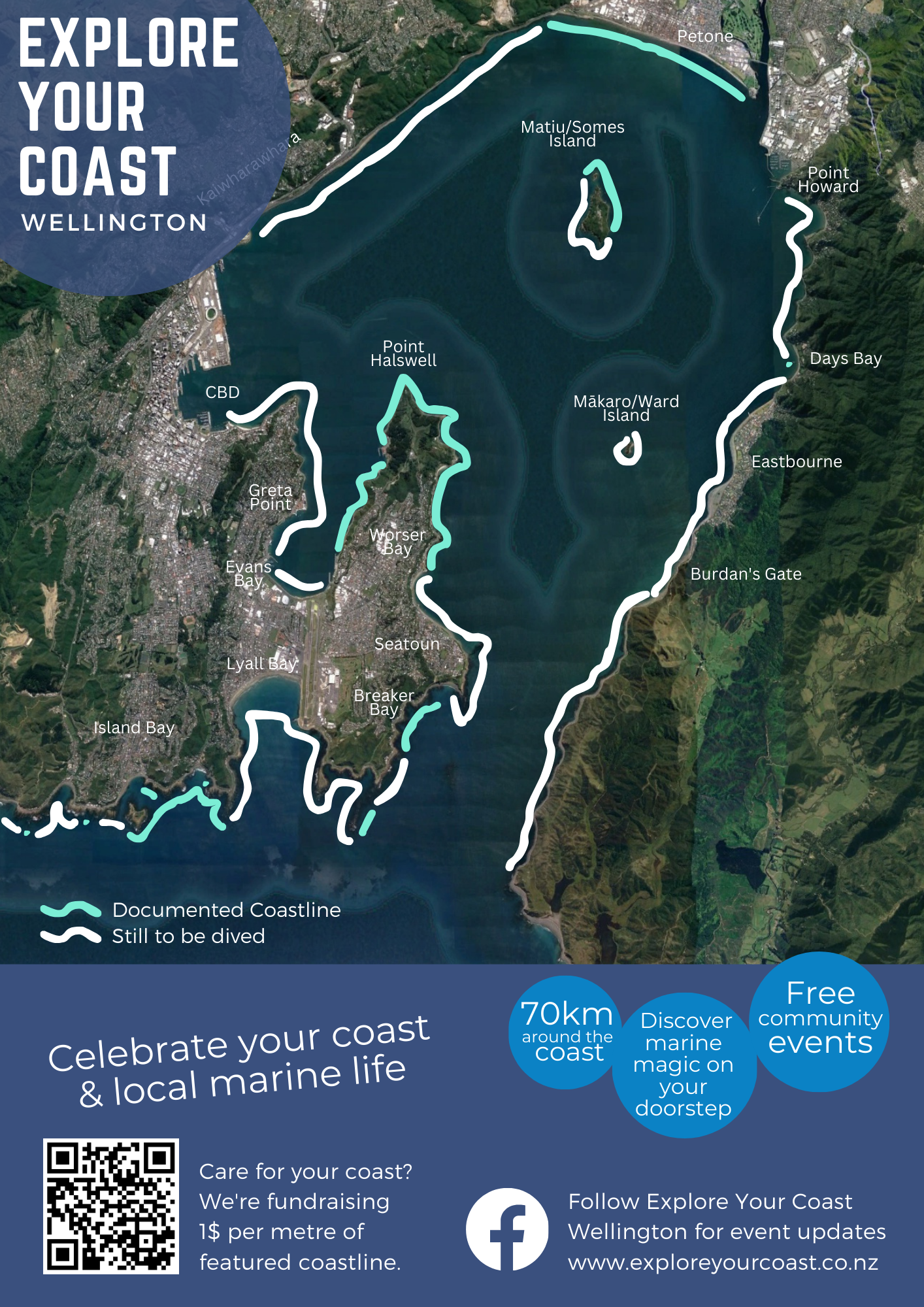
Saturday/Sunday 6/7 April
We dive from Hataitai Beach in Evans Bay north to Balaena Bay. It’s great to see some healthy looking seaweed forest at the back of NIWA. I get buzzed by different schools of fish — baitfish, some small and medium sized jack mackerel and some butterfly perch. Towards the northern end of the seawall the seaweed thins out and once we start diving north we are diving mostly over kina barren with some sparse seaweed patches and seaweed in the shallows.
I still have about 42.5km to dive. With the recent dives, it is clear to me that an unseen ecological disaster is unfolding in Wellington Harbour. The rocky reefs around Wellington should be covered in seaweed forests, thriving ecosystems that provide the habitat for pāua, crayfish and hundreds of other species that in turn attract other animals and form the basis of a food web that includes penguins, dolphins and us.
Besides seaweed forests, we have many more diverse and significant habitats in Wellington Harbour and around the coast. We find colourful sponges along large stretches of Wellington harbour around Miramar peninsula, Evans Bay and into the city in around 8-12 metres depth. Sponge scientists estimate the sponges filter approximately 1 billion litres of water every day in the harbour. They also create a sponge detritus that is edible by smaller sea creatures and like seaweed forests provide three-dimensional structures and habitat for other species.
While it will take a lot longer than initially planned to scuba dive and film 70km of Wellington’s coastline, the last couple of months have been a good start. Later this year I will use my Winston Churchill Memorial Trust Scholarship for an overseas research trip learning about community-led marine restoration, the role of citizen science and funding of large scale restoration in North America, Europe and Australia.
Observations are inspiring and initiating action, which is why I’m doing this dive with mostly my own resources. I am passionate about our marine ecosystems and strongly believe a healthy ocean can benefit local communities — from sustainable food sources and recreational activities to economic opportunities and skilled-jobs.
Toitū te marae a Tāne-Mahuta, toitū te marae a Tangaroa, toitū te tangata. If the land is well and the sea is well, the people will thrive.

Taputeranga Marine Reserve (Mermaid’s Kitchen)



